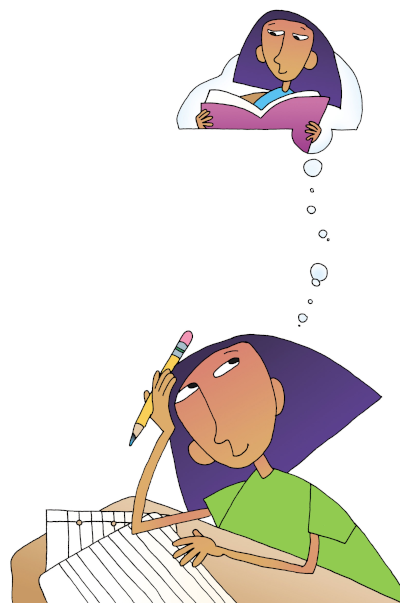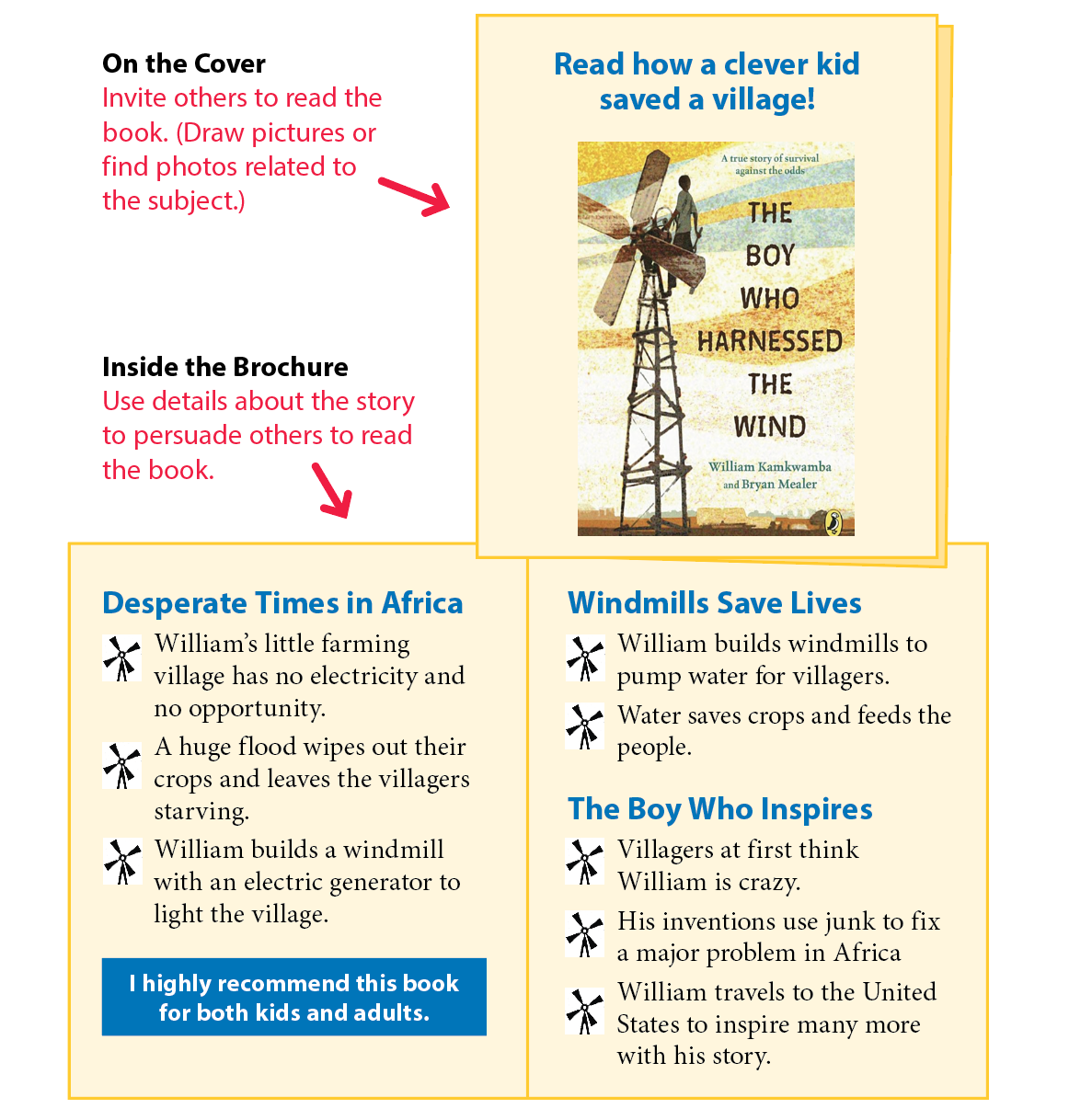Page 223
Writing Book Reviews

Some books take you to the wonders of the world—the Pyramids of Giza, the Grand Canyon, the Eiffel Tower, Mount Fuji, Niagara Falls. . . . Other books whisk you away to wonders of imagination—the Magic Tree House, the Land of Oz, Wakanda, Hogwarts, Hobbiton. . . .
A book review acts as a tour guide to these real and imaginary places. When you write a review, you share with classmates where you have been and encourage them to take the adventure themselves.
This chapter will help you write strong reviews of fiction or nonfiction and invite friends to take their own journeys.
What’s Ahead
WE 224
Page 224
Sample Nonfiction Book Review
In the following model, Missa Ortega reviews the nonfiction book The Boy Who Harnessed the Wind. The review gives just enough information to help readers decide whether or not to read the book.
The Boy Who Harnessed the Wind
Beginning
The first paragraph introduces the book and gets the reader’s interest. The Boy Who Harnessed the Wind tells the inspiring story of William Kamkwamba, who lived in a remote village in Malawi, Africa. Imagine living where there is no electricity and the only work is on family farms. Then a flood comes!
What is the book about?
Middle
The middle paragraphs summarize the details covered in the book. William and his cousin Geoffrey work on small farms in Masitala Village. They like to take apart old radios to learn how they work. Soon they can fix radios and bikes for other villagers.
Then a huge flood wipes out the crops. People start to starve. William and his family cut back to one small meal a day. He hopes to go off to school, but his family can’t afford it.
That’s when William’s tinkering helps him. He builds a windmill and uses a generator from a bicycle to create light for the villagers. They think he is crazy at first, but William next builds a bigger windmill to power a water pump.
What do I like about the book?
The reviewer makes a personal connection with the book.
William doesn’t have much, but he never gives up hope. He lets his interest in gadgets become a way he can help his village and save their farms. He makes windmills that water crops and feed people. In fact, William is so successful he travels to the United States to see the giant windmills that inspired him. He even presents a TED Talk about his work.
What is the book’s theme?
This book shows how curiosity and persistence can turn a desperate situation around. William uses library books and spare parts to invent a solution that changes lives. Instead of giving up, William gets to work. He doesn’t listen to doubters but instead makes believers out of them. He even writes this book!
Why would others like this book?
Ending
The last paragraph encourages others to read the book. The Young Readers’ edition of this book is easy to read and has many interesting illustrations. It lets you feel like you live in Masitala Village with William and can help him overcome many challenges. It is inspiring!
WE 226
Page 226
Sample Fiction Book Review
In the following model, Luke Bromwell reviews a mystery titled The Real Thief. Luke’s review shows that he has thought very carefully about this exciting book. And he says just enough to help others decide if they want to read the book.
The Real Thief
Beginning
The first paragraph introduces the book and gets the reader’s interest. One day, sometime during the Middle Ages, valuable jewels disappear from the Royal Treasury. Rubies, gold ducats, and the world-famous Kalikak diamond are missing! And so begins an exciting mystery by William Steig, The Real Thief.
What is the book about?
Middle
The middle paragraphs answer three questions about the book. Everyone thinks Gawain robbed the treasury. Who else could it be? Other than King Basil, only Chief Guard Gawain holds keys to the vault. And even though Gawain is innocent and has always been loyal to the king, the townspeople find him guilty. Gawain escapes and runs away to live by himself. Then something surprising begins to happen. Will Gawain ever come back? How does he feel now about the townspeople?
What do I like about the book?
I loved reading this mystery. I kept wondering what would happen next. It was interesting, too, to watch how the characters acted. Questions kept popping up. Why would the king think his most loyal friend would steal from him? How does Gawain feel about the king’s betrayal? Why was the trial so exciting and thrilling to the townspeople?
What is the book’s theme or message?
This book is all about loyalty, honor, and forgiveness. It really made me think: What do I do when I think someone has been falsely accused? Would I do the right thing?
Why would others like it?
Ending
The last paragraph answers a final question. In this book, poor Gawain is suspected, taken to court, and found guilty. Things do not look good for him. How will anything turn out right? If you want to find out how things turn out, you’ll have to read this book. If you like a good mystery or a suspense-filled story, this is the book for you.
Note When you write your book review, you do not have to include the four questions, as Luke’s review does. That’s your choice. But, whether you list them or not, you will want to answer each of them somewhere in your review.
WE 228
Page 228
Writing Guidelines
Prewriting Planning Your Book Review
Choose Your Topic 🟪 First, choose a book you want to review. You can read a mystery, an adventure story, a book about your favorite sports figure, or even a book of poems. Pick a book that you enjoyed and want to share with others.
Gather Your Thoughts 🟪 Next, answer four basic questions about the book: What is the book about? What do I like about the book? What is the book’s theme or message? Why would others like it? (See the next page for more information.)
Writing Developing Your First Draft
Share Your Thoughts 🟪 (1) In the first paragraph of your book review, give the book’s title, the author’s name, and a general idea of the subject of the book. (2) Then, in separate paragraphs, answer the first three questions: What is the book is about? What do I like about the book? What is the book’s theme or message? (3) In the last paragraph, answer the final question: Why would others like it?
Revising Improving Your Book Review
Make It Clear 🟪 Check your first draft for ideas. (1) Did you introduce the book? (2) Did you answer the four basic questions about it? (3) Did you end with an invitation to read the book? (4) Overall, did you share enough details about the book, without giving the whole story away?
Editing and Proofreading Polishing Your Review
Check It Over 🟪 Correct any errors in capitalization, punctuation, and spelling. Remember that book titles must be underlined or italicized. Then write a neat final draft and proofread it line by line. (See page 66 for an editing checklist to use as a guide.)
Choose Your Topic 🟪 First, choose a book you want to review. You can read a mystery, an adventure story, a book about your favorite sports figure, or even a book of poems. Pick a book that you enjoyed and want to share with others.
Gather Your Thoughts 🟪 Next, answer four basic questions about the book: What is the book about? What do I like about the book? What is the book’s theme or message? Why would others like it? (See the next page for more information.)
Writing Developing Your First Draft
Share Your Thoughts 🟪 (1) In the first paragraph of your book review, give the book’s title, the author’s name, and a general idea of the subject of the book. (2) Then, in separate paragraphs, answer the first three questions: What is the book is about? What do I like about the book? What is the book’s theme or message? (3) In the last paragraph, answer the final question: Why would others like it?
Revising Improving Your Book Review
Make It Clear 🟪 Check your first draft for ideas. (1) Did you introduce the book? (2) Did you answer the four basic questions about it? (3) Did you end with an invitation to read the book? (4) Overall, did you share enough details about the book, without giving the whole story away?
Editing and Proofreading Polishing Your Review
Check It Over 🟪 Correct any errors in capitalization, punctuation, and spelling. Remember that book titles must be underlined or italicized. Then write a neat final draft and proofread it line by line. (See page 66 for an editing checklist to use as a guide.)
WE 229
Page 229
Collection Sheet
The ideas below will help you answer the basic questions about either a fiction book or a nonfiction book. The last question will help you invite others to read the book.
1. What is the book about?
Fiction
What happens in the story? A good book review should highlight a few events rather than tell the whole story.
Nonfiction
What is the basic subject of this book? Generally, what happens? Is there one part that seems really important?
2. What do I like about the book?
Fiction
Does the book start in an exciting or interesting way? Does it contain a lot of action or suspense? Do I admire the character’s actions? Is the character like me?
Nonfiction
Does the book contain interesting and easy-to-follow information? Does the book include some useful diagrams or colorful illustrations?
3. What is the book’s theme/message?
Fiction
What message about life is the author sharing? Here is an example: It’s not always easy to stand up for what is right. Themes about ambition, courage, jealousy, good vs. evil, and happiness are common. What details or events in the story help show the theme?
Nonfiction
Why did the author write this book? What basic information or message does the author share?
4. Why would others like it?
What is special about the book? What interest area does it cover?
WE 230
Page 230
Sample Book Review Brochure
Another way to write a book review is to make a brochure. Book review brochures use words and pictures to invite others to read the book.

Teacher Support:
Click to find out more about this resource.
© 2025 Thoughtful Learning. Copying is permitted.
k12.thoughtfullearning.com